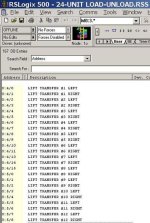All,
I am new to this site and to PLC programming. I have come across a complex challenge and am hoping I can get guidance from someone here.
I am attempting to revamp a current set of logic to increase throughput through a specific process.
The Process:
Units travel along a main conveyor and enter the "work system" and go into (1) of any (24) workstations (12 workstations on each side of the main conveyor). There, the units are processed for a varied amount of time. The units are then released, and return to the main conveyor and continue traveling out of the area.
Currently, only one unit is allowed to be on the main conveyor at a time, unless the leading unit is exiting the system. This conservative logic was originally put in place to prevent the possibility of units colliding.
My goal is to increase the throughput of units through this work system by enabling multiple units to occupy the central conveyor at a time as long as certain conditions are met.
The Roadblock:
Due to my limited experience with ladder logic, I am having difficulties being able to track units through this process, because I have no way to identify whether a unit has been processed (whether it is entering or exiting).
The process gets complicated because I can have a unit try and enter or exit from any of the 24 workstations at any time.
The I/O:
Along the main conveyor, there are (12) lift transfers (O) that lift up units and direct them to an open workstation on either side. At each lift transfer there is also a pallet stop (O) that catches units traveling down the conveyor and a Prox sensor (I) telling the system a unit is present. Each workstation also has its own Prox sensor (I)
If anyone has suggestions I would greatly appreciate them. I have attached an image I created that shows the layout of the area and the locations of the I/O.
I would be happy to provide additional information if any is needed.
Thank you everyone!
Mike
I am new to this site and to PLC programming. I have come across a complex challenge and am hoping I can get guidance from someone here.
I am attempting to revamp a current set of logic to increase throughput through a specific process.
The Process:
Units travel along a main conveyor and enter the "work system" and go into (1) of any (24) workstations (12 workstations on each side of the main conveyor). There, the units are processed for a varied amount of time. The units are then released, and return to the main conveyor and continue traveling out of the area.
Currently, only one unit is allowed to be on the main conveyor at a time, unless the leading unit is exiting the system. This conservative logic was originally put in place to prevent the possibility of units colliding.
My goal is to increase the throughput of units through this work system by enabling multiple units to occupy the central conveyor at a time as long as certain conditions are met.
The Roadblock:
Due to my limited experience with ladder logic, I am having difficulties being able to track units through this process, because I have no way to identify whether a unit has been processed (whether it is entering or exiting).
The process gets complicated because I can have a unit try and enter or exit from any of the 24 workstations at any time.
The I/O:
Along the main conveyor, there are (12) lift transfers (O) that lift up units and direct them to an open workstation on either side. At each lift transfer there is also a pallet stop (O) that catches units traveling down the conveyor and a Prox sensor (I) telling the system a unit is present. Each workstation also has its own Prox sensor (I)
If anyone has suggestions I would greatly appreciate them. I have attached an image I created that shows the layout of the area and the locations of the I/O.
I would be happy to provide additional information if any is needed.
Thank you everyone!
Mike






